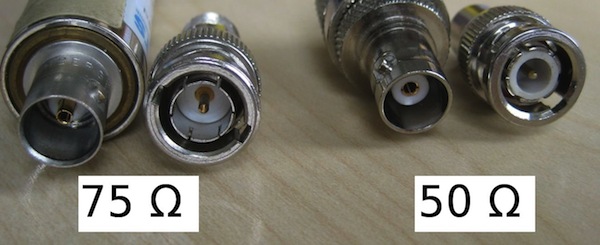Use 50 ohm BNCs, not 75 ohm
Coax BNC cables come in two flavors, 50 ohm and 75 ohm. For experimental rigs (PMTs, DAQs, amplifiers), always buy 50 ohm cables. The 75 ohm versions are for video applications, so they’re what you’ll typically find in consumer electronics stores.
The connectors are interoperable, so it can be difficult to tell what you have. The picture above should help.
In most applications, you won’t see much of a difference if you use a 75 ohm cable where a 50 ohm cable is supposed to be. But it is an impedance mismatch, and in some cases there will be a degradation of the signal. Just buy 50 ohm cables unless you’re doing something in video with instrumentation built to take 75 ohm cables.
When ordering: “RG58” is a common type of 50 ohm connectors, and “RG59” is a common type of 75 ohm connectors.

The impedance of the bnc cable (about 100pF/m) is only cancelled if a suitable termination is used, i.e. provided in the receiving box. But this divides the signal by 2, which is rarely desired or planned for. So in practice nearly all bnc cables used in electrophysiology, be they 50 Ohm or 75 Ohm, present a strong ‘impedance mismatch’. This capacitance can often make output opamps oscillate, especially for longer cables.
Is there much of a difference in the construction of coax (RF, 50 & 75ohm) compared to SDI HD & 3D SDI cables? I haven’t found diagrams showing the difference. Thank you!
Also, always use quality connectors: Amphenol or similar. Cheap connectors from your local project store can create problems down the road.
Quality RG58 is also important; cheap cable has a lower shield coverage factor.
also like to use RG174 cable which is a thin , for most short run interconnects. However, watch the shield factor, and get the 95% coverage if you can.